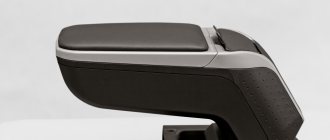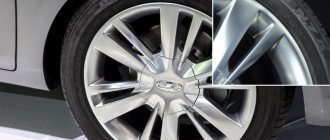Over the past decade, AvtoVAZ has been gradually moving away from the Soviet style in car manufacturing. Sedans, hatchbacks, station wagons and crossovers from Togliatti are becoming more and more similar to European-style cars. Step by step, the concern's designers are producing more and more modern cars, both externally and under the hood. Today, the most striking proof of AvtoVAZ’s progress is the Lada Vesta. In this article we will compare this model with the Lada Granta, which costs much less, but still loses consumers due to the success of Vesta.
How did Granta and Vesta appear?
The first car from the modern VAZ era was the Lada Kalina. Produced in three bodies, it quickly became popular due to its accessibility. Later, the Tolyatti concern launched into mass production another sedan designed from scratch - the Lada Priora. This model outdid its predecessors and created a sensation among young people who fell in love with tinted windows and lowered bumpers.
For a long time, Priora was the leader among domestic sedans, until VAZ presented the Lada Granta. This device, in fact, is in many ways similar to the previous model and suggests that the prototype for the creation of the Grant was Priora. Both cars remained relatively affordable for the population, so demand did not fall for a long time.
This happened before the appearance of Lada Vesta. The radically new design and status of this model predicted Granta's loss of consumers. After the launch of Vesta sales, it really took away some of the fans of other sedans. But not everyone sees the point in overpaying for the ultra-modern look of a new product, being content with the affordability and convenience of the Grant.
Therefore, you should carefully study the differences and similarities of the rivals in order to draw a conclusion: Vesta or Grant. Many articles also make comparisons: Kalina or Vesta, Vesta or Largus, Vesta or Priora. Today we bring to your attention the battle between Lada Vesta and Lada Granta.
Lada Vesta and Lada Granta - Drawing conclusions
LADA GRANTA attracts with its price, better cross-country ability, due to the highly raised body, and also has a very spacious trunk. It has several body types and more configuration options. It is well suited as a family or even work car, especially if the buyer is not looking for external beauty and presentability.
LADA VESTA has an excellent exterior and benefits from technical characteristics. Vesta tries not to be inferior to foreign cars of its level. The cost is somewhat high, but the availability of additional options compensates for this disadvantage. Soon it is planned to release new body types, as mentioned above, station wagon and hatchback. According to Vesta fans and experts, then they will definitely have no equal, because they promise to be improved in all existing gaps and focused not only on an urban, comfortable driving style.
Buyers can boast of the Lada Vesta, compared to previous VAZ models. But it is still very difficult for it to compete with competitors from foreign manufacturers. Nevertheless, Lada Vesta is trying not to yield to foreign cars of its level.
You can also read on this topic:
Tuning the interior of the VAZ 21213 - a new look for the Niva Taiga
Hyundai ix35 and Kia Sportage on the secondary market: what are the problems with these models
The Germans began selling a modernized Volkswagen Amarok pickup truck in Russia
A year has passed since the start of serial assembly of Lada Vesta: time to take stock
Do-it-yourself VAZ 2110 engine tuning seriously increases power
Share on social networks
Dmitry Seregin July 31, 2017
Published in: Russian cars
Tags: AVTOVAZ, car market, In Russia, Our cars, Russian cars
Body comparison
Let's start with a comparison of bodies. There is an advantage of Vesta in terms of dimensions:
- length (by 150 mm);
- width (difference – 64 mm);
- ground clearance (18 mm gain with manual and 33 mm with automatic);
- weight (1.23 t versus 1.075);
- the size of the wheelbase (the gap is decent - 159 mm).
Despite this, Granta is 3 mm taller than its opponent. Also, the geometric capacity of the Vesta luggage compartment is 40 liters less. Grant also has a huge plus - the price.
Lada Vesta is a more expensive pleasure, so with all its appearance it is designed to prove that it is worth the money. This is not so easy to do, since Grant's liftback is released from the opponent's side. The new model cannot yet boast of an abundance of bodies. In this regard, the question is again relevant: Kalina or Vesta, since the “miniature” model is produced in 3 variations, a sport version, and also a Kalina cross version.
Soon the new product will appear in hatch, station wagon, and cross-version bodies, and then, most likely, the question of which is better, Kalina or Vesta, will be removed.
Appearance of opponents
Granta looks much sparse in appearance. Its front end is represented by triangular headlights, a radiator grille with a metal insert and an air intake that is located along the entire front bumper. Neat foglights complete the look.
You may be interested in: Size of windshield wipers on Lada Vesta: choosing the best
In profile, Granta does not differ in particular individuality. Smoothed doors and wings are made without sharp transitions. The back from the side looks a little disproportionate. The trunk lid has huge dimensions, and the numbers are located on the bumper.
Vesta style is the exact opposite. At the front, the radiator grille joins together with the air intake, forming the letter X. Chrome trim adds solidity. The headlights have a sporty, modern design.
In profile the pose is even more advantageous. Stamped inserts on the fenders give the body a voluminous effect. It looks very good. There are X-shaped lines along the entire sidewall, which will prevent Vesta from being confused with anything. Large, stylish wheels complement the flattering side view.
The rear view of Vesta lags behind the front and profile, but is also ahead of the rear projection of Grant. Straight headlights, an impressively sized bumper with a black insert and a luggage compartment lid that is more proportional than that of its rival. In addition, it does not seem empty, since it has a license plate and four huge LADA letters.
Body: comparison and characteristics
Looking ahead, we can say that in this category the Lada Granta wins with its high ground clearance, height and trunk capacity.
Features of the LADA Granta car
When designing the liftback body, nothing out of the ordinary was envisaged. Everything is modest, economical and as practical as possible. The front of the car generally looks quite rough. The disproportionately large headlights and radiator grille occupy almost the entire front part. Immediately under the radiator grille of the Lada Granta, there is an air intake that fills the front bumper. The presence of fog lights is provided for in the selected configuration. The body is devoid of chrome accessories. Along with the front dimensional parts, the side doors stand out for their scale, the trunk door looks especially massive.. The body itself is not uniform, somewhat enlarged due to the rear part. There is a logical explanation for this, so the designers increased the volume of the rear trunk. For some, this will be a significant advantage, and will influence the choice - to buy Grant rather than Vesta.
Recommended article: Fuel consumption of the UAZ Patriot of the updated model has decreased
Features of the Lada Vesta car
The front part of the body looks quite harmonious due to the assembled headlights, radiator grille and air intake, framed by a chrome outline. the Lada Vesta looks just as attractive ; the bumper has an overlay and a reflector, but the headlights, or rather their smooth curves, are especially advantageously designed.
Engine overview
Just six months ago, Grant would have been the winner in terms of the number of engines. Since Vesta was previously produced with only one power unit. Today, the new product has three options for gasoline engines.
| Power | Peculiarities |
| 106 strong. | VAZ engine with a volume of 1.6 liters, which was installed on Vesta as the only possible one from the beginning of production (4-cylinder 16-valve with a maximum torque of 148 Nm). |
| 110 hp. | A deformed 1.6-liter Nissan unit (also has an in-line arrangement of 4 cylinders, the number of valves is 16, the maximum thrust is 150 Nm). |
| The most powerful engine with 122 hp. With. | The 1.8 liter engine is a completely unchanged engine from the Lada X-ray. |
Granta also has an injection engine with a power of 106 horsepower, with completely similar characteristics to the Vesta engine. Cars exchange hundreds with this unit in different ways. Granta, due to its lower mass, reaches 100 km/h in 10.9 seconds, and Vesta spends almost a second longer on this (11.8 s). With the “robot” gearbox, acceleration takes even longer – in 12.8 seconds. The fuel consumption of competitors with a manual transmission on this engine is almost identical: almost 9 liters in the city, more than 6.5 on the highway. The maximum speed, surprisingly, is higher for the Grant: 183 km/h versus 178.
The budget sedan also has two less powerful units: a 16-valve (98 hp) and an 8-valve (87 hp). In terms of dynamics, they are not competitors to Vesta engines, but installing such engines significantly reduces the price of the Granta, which is a plus. By the way, the 98-horsepower engine is only available with an automatic transmission.
Thus, we see parity in the number of engines 3:3. Vesta has an advantage in power and dynamics, while Granta has an advantage in price.
Specifications
The length/width/height/wheelbase of the Lada Vesta 2020 is 4410/1764/1497/2635 mm, and the Lada Granta 2020 is 4268/1700/1500/2476 mm. The ground clearance is the same - 180 mm. The volume of the fuel tank is 5 liters larger in Vesta - 55 versus 50 liters, for which 92nd gasoline is indicated as recommended, and not 95th, like its opponent. But the luggage compartment of the Grant is more spacious - 520 versus 480 liters. The curb weight is expected to be higher for a larger sedan - 1230-1380 kg versus 1075-1160 kg.
Rivals share one 1.6-liter 16-valve petrol engine with 106 horsepower and 148 Newton-meters of torque. Lada Vesta 2020 can also be equipped with a 1.8-liter gasoline engine (122 hp, 170 Nm), and Grant 2020 - with a 1.6-liter 8-valve (87 hp, 140 Nm) and 16- valve (98 hp, 145 Nm). The line of transmissions is represented by two identical 5-speed manual and robotic gearboxes. But Granta also offers a 4-speed automatic transmission.
This is interesting: The coolest (expensive) limousines in the world: top best representatives
Now let’s compare the dynamic characteristics and fuel efficiency of our opponents. Acceleration time from 0 to 100 km/h (gasoline consumption in city/highway/mixed modes) for Lada Vesta 2020 vs Lada Granta 2020 is:
- 1.6 (106 hp) 5MT - 11.2 s (9.3/5.5/6.9 l) vs 10.5 s (8.7/5.2/6.5 l);
- 1.6 (106 hp) 5AMT - 14.1 s (9.0/5.3/6.6 l) vs 12.0 s (8.7/5.2/6.5 l).
We will separately indicate the data for the remaining modifications:
- Vesta 1.6 (122 hp) 5MT - 10.2 s (9.5/6.2/7.4 l);
- Vesta 1.6 (122 hp) 5AMT - 12.1 s (9.3/6.0/7.2 l);
- Granta 1.6 (87 hp) 5MT - 11.6 s (9.1/5.3/6.8 l);
- Granta 1.6 (98 hp) 4AT - 13.1 s (9.9/6.1/7.2 l).
As we can see, in versions of the Grant models comparable in engine power and gearbox type, we have an advantage in both dynamics and fuel efficiency.
Car appearance
When Grant's car was released, many considered this to be a turning point, because after Samara, this car became more streamlined and much more stylish on the outside. However, Vesta has made an incredible leap forward and, compared to the simple Granta, she looks simply amazing.
The Granta was originally created as a modest and budget version of the car, which is why quite large headlights appeared here, as well as a massive radiator grille, under which an equally massive air intake is used, which is located along the entire length of the bottom of the car bumper. Quite massive round fog lights emphasize the car's style. In this case, chrome is not used almost anywhere - the only place where it is present is the strip on the radiator grille.
Once the car is fully examined from the side, one can highlight the rather large doors, as well as the incredibly long rear. It is clear that all this was done with only one single purpose, to maximize the luggage compartment space. Despite this, for many people, this exterior option looks very ridiculous.
Looking at the back of the car, the feeling of absurdity only increases. There's a simple, huge trunk lid that literally hangs over the main part of the car. The license plates are mounted on the bumper, which also doesn’t look quite right. As a result, the license plate is constantly covered in dirt in the spring and autumn.
As for the Lada Vesta, it looks much more interesting. In this case, the aggressive features of the car look very dignified and do not evoke any negative emotions. The front of the car stands out with chrome trim. The radiator grille and air intake are connected into a single whole, and it looks quite interesting. All this looks much more profitable than the Grant option.
The side of the car looks even more stylish and high quality. In this case, there are no huge doors, large rear wings, or simple wheels. Instead of all this, there are interesting and unusual lines in the form of the Latin letter X, which are located on both sides of the car. The wedge-shaped profile also looks unusual, especially considering the fact that this is a domestic car.
The back of Vesta also looks much more attractive. Everything here is done very correctly and original, from the large bumper to the more expressive taillights.
Transmission comparison
The new product from VAZ has two five-speed gearboxes. One of them is a product of the domestic industry, the other is being developed by Renault engineers. Granta can boast of only one type of transmission. Owners and professionals note clearer and more balanced operation of the boxes on the Lada Vesta.
This is interesting: TOP of the best Chinese cars: rating of the most reliable, descriptions, characteristics, prices
The robotic machine is also mounted on both models. These transmissions are developed on the basis of a manual transmission with the addition of actuators and a control unit.
Car chassis
From the point of view of design features, everything is almost the same here. As for the multi-link suspension option, neither of the two car models can boast of this achievement. Despite these similar indicators, driving the Lada Grant will be a little softer and easier - the car is much less susceptible to stalling on sharp turns.
Car interior
According to this indicator, Vesta is simply beyond competition. In Vesta, everything is done according to the latest technical features. The dashboard looks quite stylish and high-quality, although, alas, there are no special frills in the form of a large screen and high-quality climate control. In general, everything is done quite standardly, but for domestic cars this is considered a real breakthrough.
Granta looks completely absurd by this indicator. Here is the simplest dashboard, the dashboard looks very vague, the seats are amorphous, and the back row is generally very narrow.
Ultimately, both of these cars deserve attention, although if you need a more stylish and modern car, then you should buy Vesta.
Salon and trunk
Vesta has a more modern interior design and better quality finishing materials. But it’s one thing to evaluate the interior in absentia and quite another to be inside the car. In the latter case, we do not undertake to guarantee unambiguous assessments, as in the case of the exterior. Some people like the sophistication of the Vesta panel, others like the presence of cruise and climate control in the liftback. There are those who experience irritation, trying to connect their gadget to the Granta USB connector, securely hidden in the depths of the glove box, but there are also those who find it difficult to get used to the wayward handle for adjusting the backrest tilt, which tends to slam the rider’s face into the dashboard or, conversely, put it in the back seat.
Salon Lada Granta
Like any modern foreign car, Vesta's multimedia system control buttons are located on the steering wheel. Conservatives won't like it, but you get used to good things quickly. The Granta has other advantages and benefits - for example, a shelf for small items located on the right above the glove compartment. But even in the maximum configuration there is still a feeling that the designers saved on literally everything. This is manifested in the outdated design of the “tidy”, and in the archaic steering wheel, and in hard plastic.
There's plenty of room in the back, but tall passengers will have to be careful. Leaning back, they will certainly encounter reality, that is, the ceiling. Vesta has an advantage in the legs, but Granta has more space for feet and knees in the liftback body.
It’s really not easy to determine which is better, the interior of the Vesta or the Granta, so let’s move on to the trunk. The favorite has one drawback - the trunk responds to pressing a button on the key fob with a noticeable delay, which can irritate temperamental car owners. But the luggage compartment itself is wider and more spacious than that of the Grant liftback (480 liters versus 440), but the situation changes dramatically when it comes to a sedan: 520 liters is one of the best indicators in this class. Let’s add that here the interior space is organized more thoughtfully; the Granta has too high sides, which makes stowing luggage more difficult, and the lid’s strongly protruding hinges get in the way. The folded back of the rear sofa does not form a flat surface.
So we give Grant a slight advantage in terms of trunk space.
Dynamics, fuel consumption
The Granta is a little heavier than its competitor, but in general the acceleration characteristics of its engines are slightly higher, which cannot be said about the speed ceiling.
This is interesting: Which brands of jeeps are the largest in the world?
Lada Vesta sedan
But let's look at the differences in the dynamics and efficiency of Grant and Vesta in specific figures.
With the weakest 87-horsepower power unit, the Granta accelerates to 100 km/h in 12.2 seconds with a manual transmission. A car with a 98-horsepower engine and automatic transmission accelerates in 13.3 seconds. Moreover, the maximum speed in the first case is 167 km/h, in the second – 175 km/h, and consumption – 9.0/5.8/7.0 and 9.9/6.1/7.6 liters per 100 kilometers respectively.
The option with a 106-liter base engine has different performance for robotic and manual transmissions:
- acceleration: 12.3 and 10.9 seconds;
- max speed: 180 and 183 km/h;
- consumption: 9.0/5.2/6.6 and 8.6/5.6/6.7 liters per 100 kilometers, respectively.
Compared to Granta, Vesta has the following indicators:
| Manual transmission / 106 hp | AMT/106 | Manual transmission / 122 | AMT/122 | |
| Acceleration, sec. | 11,2 | 14,1 | 12,1 | 11,2 |
| Max speed, km/h | 175 | 178 | 186 | 180 |
| Consumption (city/highway/average) l. per 100 km. | 9,3 / 5,3/ 6,8 | 9,0 / 5,3 / 6,1 | 9,3 / 6,0 / 7,2 | 10,7 / 6,4 / 7,9 |
Controllability and safety
The vehicle's agility and maneuverability are tested on high-speed zigzag sections of roads. Here Vesta’s advantage is obvious - it holds the road more confidently and reacts adequately to steering turns. But the ABS system is too sensitive; at the slightest suspicion of slipping of the front wheels, it immediately slows down to reduce speed. This moment can irritate beginners, but once they get used to it, they confidently predict this moment and reduce the force transmitted to the accelerator pedal in advance.
On the Lada Granta, ABS does not work so quickly, so here the enthusiastic driver has many opportunities for various strength exercises. As for handling on a flat road, Vesta’s behavior can be called ideal, while a competitor on a bumpy road can jump off the trajectory, requiring an adequate response from the driver.
Lada Granta
But in terms of safety level, it’s not worth comparing the Lada Granta and Vesta - the latter already contains an impressive list of options in the database, at least twice as large as those of its rival.
Rival transmissions
In this component, Lada Granta has a slight advantage. It has three transmission options: one manual and two automatic. The mechanics are the VAZ 2181 model. The domestic manual gearbox is slightly inferior to its Vesta counterpart. The automatic transmission is a robotic transmission and a classic automatic transmission, which the new product cannot boast of.
You may be interested in: Choosing an armrest for the Lada Vesta
Vesta has been available with one mechanical option since the fall of 2020. This is a modified version of the 2180 box and is now designated 21807. With its release, this transmission supplanted the French mechanics. It now makes a little less noise and allows you to switch speeds more clearly and smoothly. It’s difficult to put the Granta analogue on a par with the improved Vesta manual transmission.
The new product can only respond to 2 automated transmissions of a budget car with a robot. Granta, in addition to AMT, has a 4-speed classic automatic transmission. On the highway, such a box is unprofitable in terms of fuel consumption, but for the urban cycle it’s just right.
Winter comparative test of Lada Vesta, Grant, XRAY and other cars
The overall impression of operating a car in winter consists of many factors. For example, how the engine starts in cold weather, how efficiently the heater works, how quickly the car accelerates or brakes on a slippery road, or how much maneuverability the car has in the snow.
The auto magazine "Autoreview" checked how cars of different classes (Lada XRAY, Vesta, Granta, Chevrolet Niva, Skoda Octavia, Renault Duster, Hyundai Solaris, Volkswagen Polo, Kia cee'd and even UAZ Patriot) were prepared for winter. Each model was assessed according to 9 parameters, after which the leader was identified.
To ensure fair test results, all 10 cars were fitted with the same studded tires. After all the tests, the entire set of consumer properties when operating the machine in winter conditions was summarized and the leaders were identified:
- Renault Duster turned out to be the most prepared for winter and received the most points (77)
- Skoda Octavia took second place with 75 points
- Volkswagen Polo is in third place with 72 points
- Kia cee'd fourth place and 70 points
- Hyundai Solaris and Chevrolet Niva scored an equal number of points - 69.
The TOP 5 includes only foreign cars, with the exception of Niva. Even AvtoVAZ’s latest model, the Lada Vesta, failed to make it into the top five, missing only 1 point. The sedan let down its acceleration on winter roads and its cross-country ability. The XRAY crossover managed to score only 62 points; it took even more time to accelerate than Vesta. Granta failed in tests of acoustic comfort, winter road handling and acceleration.











